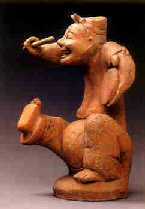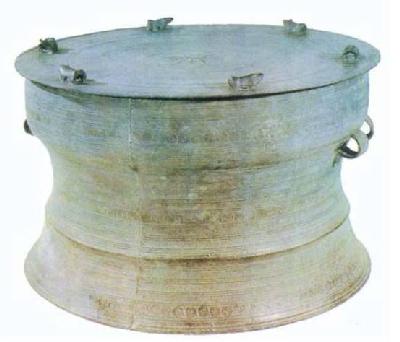| About China > History > Dynasties > dycontent |
|
|
Han Dynasty The Terracotta Storyteller of Eastern Han Dynasty The Han empire began in 206BC when Liu Bang, prince of the Han, defeated the Qin army in the valley of the Wei. The defeat was part of a larger rebellion that began after the First Emperor's death. The people were dissatisfied with the tyranny of the Qin leaders and their legalist form of government. However, while Chinese history portrays the Han as having implemented many changes to the government, evidence shows that the Han continued to rule in the tradition of the Qin, only gradually incorporating Confucian ideals into their legalist form of government. Economic expansion, changing relationships with the people of the steppes, strengthening the palace at the expense of the civil service, weakening the state''s hold on the peasantry and the rise of the rich and the gentry were all factors that led to the adoption of Confucian ideals.
Under this new form of legalism and Confucianism, rewards and punishments were still used for the common people. However, the administrators were judged according to Confucian principles with the justification for these different sets of standards as they were educated. As a last resort, the ruler could use punishment for both the people and the officials. It was believed that force alone was not sufficient enough to rule, so the emperor needed the help of the Confucians to guide him morally. Evidence of rulers using power to punish is found in records of beheaded officials.
Like the Qin before them, the main goal of the Han was to unify China. This goal led to the eventual breakup of the fiefs and the downfall of the imperial nobility. This process was finally completed during Emperor Wudi''s reign (141-87BC) -- a period of great military expansion. Emperor Wudi expanded China's borders to Vietnam and Korea and pushed the Huns to the south of the Gobi. Emperor Wudi transferred an estimated two million people to the northwestern region to colonize those areas.
The expansion also led to trade with the people of inner Asia. Thereafter, the Silk Road was developed. The Silk Road actually consisted of more than one possible route through the mountains that traders followed. Agriculture grew with the development of better tools. Iron tools were of a better quality and oxen-drawn ploughs were commonly used. Irrigation systems were increased to help develop the areas of North China. Crop rotation was also incorporated from 85BC onwards. The state attempted to monopolize the production of iron and salt, which were the two biggest sectors of the economy, but they only succeeded to do this for less than a century. Silk weaving and copper work were also important activities.
Education became more important during this period as a new class of the gentry was introduced. A result was the compilation of many encyclopedias. The best known is the Book of the Mountains and Seas, which contained everything known at the time about geography, natural philosophy, the animal and plant world, and popular myths. Sima Qian, one of China''s greatest historians, wrote his famous Records of the Great Historian (Shiji) during this time. The history book became the model by which all other histories followed. It was one of the first attempts in China to record the past in a book form.
The Han Dynasty actually consists of two separate dynasties. It is considered as one dynasty by the Chinese because the second dynasty was founded by a member of the former Han dynasty who declared that he had restored the Han Dynasty. The original Han Dynasty was overthrown when wealthy families gained more power than the emperor. The families became allies through marriage and were responsible for the selection of officials. The widow of Emperor Y¨¹andi succeeded in placing all of her relatives in government and ruled in place of her son. Her nephew, Wang Mang, eventually declared himself emperor of a new dynasty, the Xin (new). His rise as emperor is unusual because he gained much public support and began the ceremony where a seal of the precious stone was passed to the emperor. From then on, whoever held the seal was the official emperor. Wang was overthrown by a secret society of peasants known as the Red Eyebrows (they painted their eyebrows red). Descendents of the Han eventually joined in the uprising, and it was the armies of these nobles, under the leadership of Liu Xiu, who killed Wang in the year 22. The fighting continued until the year 25 when Liu became emperor. As emperor Liu was called Emperor Guang Wudi. Millions of people died during the fighting, leaving land behind for peasants, and often freedom from debt as lenders passed away.
The second Han Dynasty had much success with its foreign policy. Part of this success was due to luck rather than any great accomplishments. The Huns, previously one of the most dangerous enemies of the Chinese, were defeated by the Xiangbei and the Wuhuan. Half of the Huns moved south and became part of the Chinese empire. The Huns appeared to be trying to reunite and form a large empire comprising of Turkestan. Thus, in 73, the Chinese began a campaign in Turkestan. The whole of Turkestan -- which would have ensured a trading monopoly although Emperor Mingdi died and Changdi became emperor -- was quickly conquered. The emperor favored an isolationist policy so that much of what was gained in Turkestan was now lost. Banchao, the deputy commander who led the invasion, stayed in Turkestan to try and hold onto what was won. Eventually, in 89, a new emperor came to power with a renewed interest in holding Turkestan. Despite this military success, economic and political struggles arose in China. Internal struggles for power taxed the peasants until in 184, when another peasant uprising occurred. This movement was initiated by the Yellow Turbans and served to unite the factions that had previously been fighting because they needed to unite to defeat the Yellow Turbans. Although China had conquered them, the country did not return to a united state. Rather, three kingdoms emerged and the Han Dynasty came to an end. |
||||
 |

